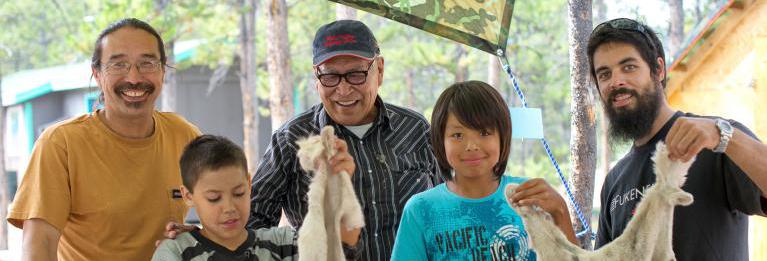
Haa kusteeyí
Culture
WELCOME TO OUR LAND! We humbly ask you to show your respect to the land while you are here.
Spirituality
Spirituality is held in very high regard within the Carcross/Tagish First Nation. Ceremony is a very important part of our life and follows the transition of ages, spanning from birth to death, and our relationship with self, clan and nation.
Our art forms express our spiritual relationship and interconnectedness with each other, the land, water and animals. Our crests and totems serve as keys to unlock a rich oral tradition of storytelling and sharing.
Hunting
To keep from over hunting the people moved around a lot from place to place depending on what they were hunting and what season it was. Moose hunting is mostly done in the fall, when the moose have gained the bulk of their weight in order to survive the long winter ahead. When a moose is shot, every part of the animal is used, not only for food, but also for tools, clothing, boats, tents, snowshoes and much, much more.
Fishing
Fish was and still is another major source of diet. Fish were mainly caught in willow or sinew nets. Fish traps, spears, bone and wood fishhooks were also used to catch fish. In order to prepare for the cold winter months a lot of fish was cut up and hung on racks to dry.
Smoked and dried meat and fish were stored in caches for later use. Families would have perished if they did not know how to preserve and store food.
Trapping
Another large part of the First Nation heritage is trapping. This is mainly done in the winter months because this is when the animals have acquired their winter coats and the fur is in prime condition. Before the exchange of money, furs were used as currency as a means of trade. Hunters caught a wide variety of fur bearing animals by snares or deadfalls using different kinds of bait. The animals were skinned out and placed on stretchers. The lightest and warmest furs were used to make robes and blankets.
Construction Material
Our people’s understanding the needs of survival and having innovative minds developed ways to work with our environment. We did not create materials, so much as use the materials that mother earth provided for us. The use of stone, wood, bones and skin provided our implements and tools. They also provided the materials needed for construction of our shelters and vehicles.
Art Forms
Our art forms developed out of the need to express our relationship with each other and creation. The crests, totems and stories do not serve an artistic purpose, so much as a spiritual expression. It’s a mixture of Coastal Tlingit and Tagish Athabaskan design. The use of color, materials and images combined to give life to our ceremonies. It has been told that the true artist is able to sing the spirit out of the wood and people.
Gathering
Gathering-Berries, herbs and plant foods are gathered (or put up) in various times of the year. Women put up a variety of berries that grow in almost every part of the Carcross/Tagish First Nation Traditional Territory that encompasses Southern Yukon, Northern British Columbia and Alaska. Most of the berries picked were mixed in grease with dried meat or fish and cached away and used only when food was low, especially in the winter months.
Traditional Medicines
The land not only serves as our grocery store, but also as our hospital and pharmacy. We know that if we take care of the land, the land will take care of us. This relationship with the land ensures that the land gives us the medicines and herbs, as well as physical and psychological healing that our people need. Most of our people understand how to gather basic medicines, and we have people that have a wealth of knowledge about the medicines that the land provides.
Carcross/Tagish First Nation Citizens, update your contact information
If you are a Carcross/Tagish First Nation Citizen and need to update or add your contact information to our database, fill out this form.